Through the big, red barn doors of Chris Gavin's Clipper Mill studio comes the sound of hammers on metal. It's a sound you might expect to hear from a metalworker's shop. What you might not expect is the massive bronze butterfly perched on a leaf that looms overhead when you step inside. Its delicate wings contrast sharply with the hulking machinery that fills the open, concrete-floored space that houses Mandala Creations in Metal.
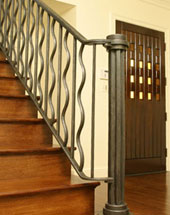 The sound, it turns out, is coming from a power hammer. This machine
does the initial rough forming of the metal, after it has been heated in a
propane-fueled forge to some 2,300 degrees. One of Gavin's assistants guides
the glowing yellow tip of a steel pole beneath the power hammer. Later, the
metal will be worked by hand with a regular, old-fashioned hammer and anvil.
The sound, it turns out, is coming from a power hammer. This machine
does the initial rough forming of the metal, after it has been heated in a
propane-fueled forge to some 2,300 degrees. One of Gavin's assistants guides
the glowing yellow tip of a steel pole beneath the power hammer. Later, the
metal will be worked by hand with a regular, old-fashioned hammer and anvil.
In Gavin's hands, a hunk of metal might become an intricate ginkgo leaf or a sturdy table base. Dressed in work boots, ripped jeans, and a Tibetan-style hat, the 44-year-old is smaller and slighter than one might expect of a man who makes his living pounding metal. The hand he extends is somewhat blackened, and he speaks with a subtle accent of his native Scotland.
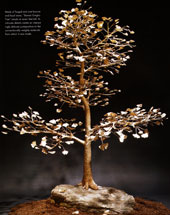 Gavin's first introduction to working with metal occurred at the Maryland
Institute College of Art, where he came as an exchange student in 1984 to study
sculpture. "I realized, as far as sculptural working media goes, that metal was
something I had a particular affinity and aptitude for;' he says. "It sparked something
in me ... no pun intended:'
Gavin's first introduction to working with metal occurred at the Maryland
Institute College of Art, where he came as an exchange student in 1984 to study
sculpture. "I realized, as far as sculptural working media goes, that metal was
something I had a particular affinity and aptitude for;' he says. "It sparked something
in me ... no pun intended:'
It wasn't until he encountered blacksmithing a few years later, though, that Gavin really began to see the potential of the medium. "Blacksmithing takes working with metal another stage further than anything I'd been exposed to in art school," he says.
Gavin is largely self-taught, having taken just two classes in blacksmithing at regional craft schools. You might think that's because most blacksmiths have gone the way of the horse and buggy. In fact, the trade is experiencing a resurgence in popularity: ABANA, The Artist Blacksmith's Association of North America, Inc. boasts almost 5,000 members. Most are hobbyists, notes Gavin. Not many have pursued the physically grueling trade as a career. "It's not an easy way to make a living;' he admits. "But there's a certain sense of satisfaction. I'm leaving something behind that's a positive contribution."
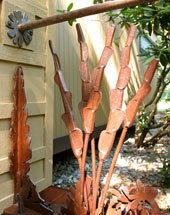 Twenty-first century blacksmiths like Gavin make use of modern technology-
like the power hammer, water jet cutters, and hydraulic presses-but have
not abandoned the basic tools of the ancient trade. All of Gavin's creations
involve some hand work. "There's something really nice about the marks left by
the hammer;' he says, running a finger over a hand-crafted table leg. "A machine
couldn't replicate that." He prefers to use as little welding as possible, joining pieces
of metal together with handmade rivets and bolts instead.
Twenty-first century blacksmiths like Gavin make use of modern technology-
like the power hammer, water jet cutters, and hydraulic presses-but have
not abandoned the basic tools of the ancient trade. All of Gavin's creations
involve some hand work. "There's something really nice about the marks left by
the hammer;' he says, running a finger over a hand-crafted table leg. "A machine
couldn't replicate that." He prefers to use as little welding as possible, joining pieces
of metal together with handmade rivets and bolts instead.
Gavin eschews labels, considering himself equal parts artist, craftsman, and designer. He is also an experienced world traveler. Mandala Creations was founded after he spent a year traveling abroad in 1995-"Just me, a backpack, and a bike;' he says. In fact, the name for his business was inspired by the cultures of Nepal and Tibet; "mandala" is a Sanskrit word meaning wholeness or circle of eternity.
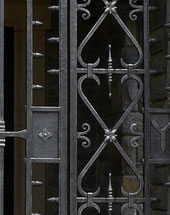 Gavin took another sabbatical in 2000 with his wife, revisiting some of the
same countries from his previous trip. He is particularly enamored by Bali, a place he calls a "great inspiration for an artist."
Gavin took another sabbatical in 2000 with his wife, revisiting some of the
same countries from his previous trip. He is particularly enamored by Bali, a place he calls a "great inspiration for an artist."
While he does create some pieces that are strictly decorative, most of his work blends function and aesthetics for instance, console tables with forged steel and beaten copper details, wroughtiron fireplace screens, and the aforementioned butterfly, which is a custom-made weathervane. "I don't think of art and craft as separate. I think there needs to be a marriage of the two:' says Gavin.
Virtually all of Gavin's creations are different. While certain designs or motifs are sometimes repeated, no two pieces are exactly alike. As one might imagine, such painstaking work doesn't come cheap. When asked who his customers are, Gavin replies, "People with money:' He's not kidding. Among his clients are CEOs as well as the clients of interior designers and architects.
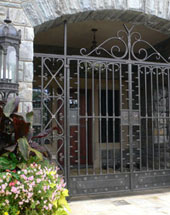 In addition to being willing to shell out, say, $8,000 for a console table,
Gavin's clients also tend to have an appreciation for pieces that are not like anything
you'd find in a store. Baltimore interior designer Rhea Arnot is one such
customer. She has commissioned Gavin's work for her own home and for her
clients. "He's a wonderful craftsman and artist:' she says. "His pieces are beautifully
finished, very artistic, beautiful quality. ...He just has a nice touch:'
In addition to being willing to shell out, say, $8,000 for a console table,
Gavin's clients also tend to have an appreciation for pieces that are not like anything
you'd find in a store. Baltimore interior designer Rhea Arnot is one such
customer. She has commissioned Gavin's work for her own home and for her
clients. "He's a wonderful craftsman and artist:' she says. "His pieces are beautifully
finished, very artistic, beautiful quality. ...He just has a nice touch:'
Arnot finds it exciting that you never know just what you're going to get when working with Gavin. "He's very good at taking suggestions and ideas, and then he goes off and comes up with some really amazing thing."
As Gavin himself puts it, ''I'm in the business of making heirloom-quality work that will stand the test of time, not something that's going to be thrown in the trash when it goes out of fashion:'
 Buzz
Buzz